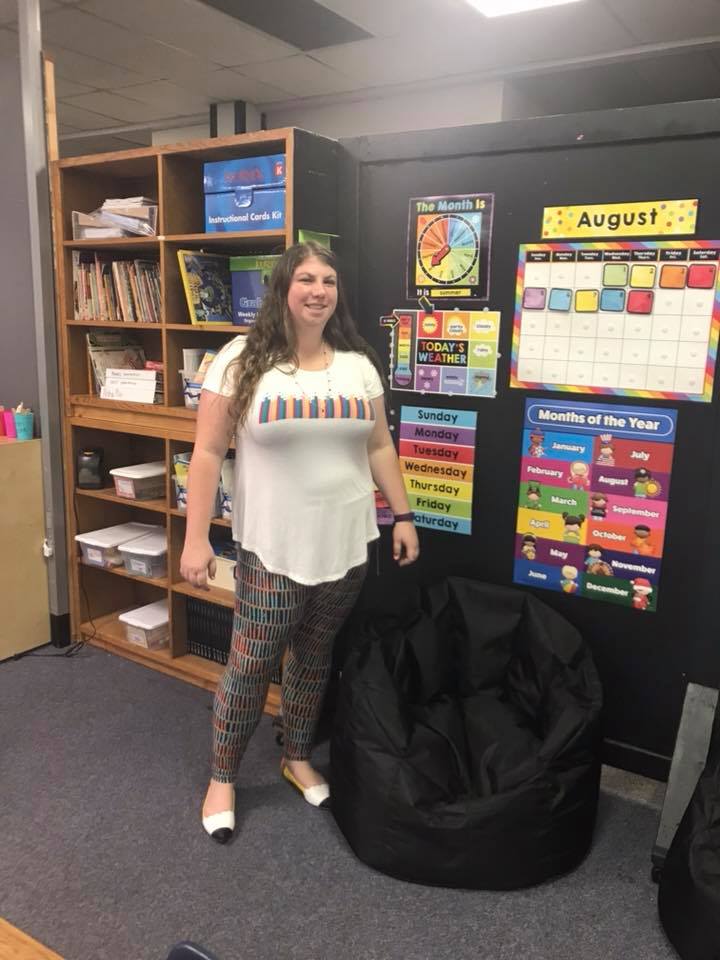Like many a bright-eyed future teacher, I began my teaching career as a student teacher in my twenties. I loved the bright-colored bulletin boards and seeing the names above every door. I loved seeing the excited students come for “meet the teacher” night, and I reveled in all the pencils, markers, and notebooks. School supplies have always held a special place in my heart. However, I was nowhere near prepared for how to cope when that name above the door was my own and those same cheerful, excited students became defiant or downright violent. My biggest faults were suddenly on display before my classroom, my colleagues, and my principal. I quickly discovered that a love for books and a deep understanding of child-development were no match for a room full of five and six-year-olds. My first years as a teacher were easily some of the most difficult of my life – to the point of almost deciding to shred my teaching certificate and apply for jobs doing almost anything else. But something inside me wouldn’t quit. I believe in education, and I know that bright futures start with education, and I wanted to be a good teacher more than anything. The truth is though, that the traditional classroom is not for me. But I am a teacher. My teaching failures helped me learn that one-size-all doesn’t fit every student, or every teacher, and that my weaknesses don’t disqualify me from making an impact on learners. On my way from failure to success, I even managed to become a leader.
My first year of teaching, I was hired to work in a small school that had been built during the era of “open concept” schools. My classroom did not have solid walls. I had makeshift ply board “fences” separating me from the classrooms on either side of mine. Starry-eyed at the idea of my own classroom, it never occurred to me how difficult it would be to teach kindergarteners in this environment. The first thing I learned was just how loud kindergarteners can be – and so did everyone else. The school culture was based on quiet. Silent hallways, silent lunchroom, silent classrooms. I had no clue how to keep kindergarteners quiet. I had no clue how hard it would be to keep them seated. I had no clue that they would shred the paper off every crayon and break the crayons….and eat the crayons. They couldn’t be trusted to use the bathroom without disrupting the rest of the building. And my lack of knowledge was on complete display to the rest of the school.
I wasn’t mean enough I was told. I was too lenient. My procedures were lacking. I couldn’t teach for lack of control over my classroom. Every conversation with my principal was about how terrible my classroom management was. Several of my students had emotional or behavioral disabilities, but they weren’t identified yet. I had never encountered children who would stab other children with their pencils. Or kids who screamed and cried nonstop when they were asked to count to 10.
I was put on a teacher improvement plan in January my first year. My so-called mentor told me she thought I might not have what it took to teach. I developed severe anxiety and couldn’t sleep for the sheer terror of having to enter the school again the next day. I left the school in disgrace at the end of the year, by my own resignation. Looking back though, I don’t think I would have been discharged. I think they needed teachers badly enough that I would have lived to fight another year, and I would have known what to expect. Leaving teachers to fend for themselves, making them feel like failures in their first year, that’s what drives a high turnover rate among teachers.
In an attempt to learn and be closer to my daughter the next year, I took on subbing at her school. It was much closer to home, and it was a much newer school than the one I left. I got to experience different ages and different classroom styles. I knew I wanted to be hired as a teacher there the following year because I liked being close to my girl, who was herself a kindergartener that year. I spent time reflecting on classroom management practices. I took professional development courses and read books. I sometimes took sub positions as a teacher assistant, so I could see good teachers in action. I knew my past failure would not look good when I went to apply for a teaching position, so I made a plan. I got certified in the district’s most high-need area – special education. And I made a good name for myself as a sub among the teachers. I did get hired at the school as a special education teacher.
Finally, I could at least survive in the classroom. I taught students with moderate disabilities and had assistants who helped with student issues and with classroom organization. I could finally focus on teaching, and they could help me maintain a calm classroom environment. That year was pretty good. I learned how to design effective lessons and how to keep track of progress. I learned a lot about education law and how to provide for students’ needs.
The next year was a different story. I got a student who was incredibly violent. She destroyed my classroom, attacked other students, and attacked every assistant who attempted to work with her. My assistants left the school one after the other, and I was left almost alone in the classroom by the beginning of October. I had ten high-need students with disabilities and no help. I was terrified that something would happen, and I would be held liable for it. Teaching had other plans for me though. Without even applying, I was offered a job at a virtual school that was ready for me to start immediately. I gave a two-week notice, and I began a wonderful new chapter.
Even though I had never taught online, the moment I held my first virtual class, I knew it was where I belonged. I quickly learned the digital environment and had very little trouble managing a virtual classroom. I was able to really plan and deliver lessons that used best teaching practices. My strength has always been pedagogical knowledge and application, and I could finally shine in the classroom because I could finally teach and not simply control chaos. I eventually transitioned to a role as a reading intervention teacher, and I have thrived in that role. I am adept at providing individualized instruction, and I can build relationships virtually that I never dreamed possible. As a virtual teacher, I’ve learned how to differentiate content, dig deep into pedagogical skills, hold students accountable for their own learning, develop closer relationships with students and their families, and collaborate with colleagues. I love not having to keep students occupied between lessons. No busywork in my classroom! I have even developed into an advocate for my students and their needs with program administrators. With my expertise and understanding of my content, classroom, and program, my administrators seek my input and advice for program decisions.
The biggest surprise to me in the last year has been my growth as a leader. This year I took on the role as the lead Tier 3 intervention teacher. My department works with the students who are struggling the most in their studies. As a lead, I serve other teachers as a trusted peer advisor, help train new teachers, provide lesson feedback, facilitate meetings, and provide professional development resources. Growing into the role of lead teacher has been both personally fulfilling and has made a positive impact on my department and school.
Just like not every student is a fit for the traditional classroom model, neither is every teacher a good fit for that model. Teaching is hard, and it takes time to learn. It requires so many skills you will never consider until you have to do the job. If you value education and care about students, then there is a teaching situation out there for you. Students aren’t cookie cutter copies of each other and neither are we. I can honestly say I am proud of who I have become as an educator because I didn’t let failure win. Growth mindset isn’t only for students, it’s a value to live out every single day. When I think about my career as an educator, I’m excited for what my future holds as a leader in education because I know that setbacks are simply life’s learning experiences.


Leave a Reply